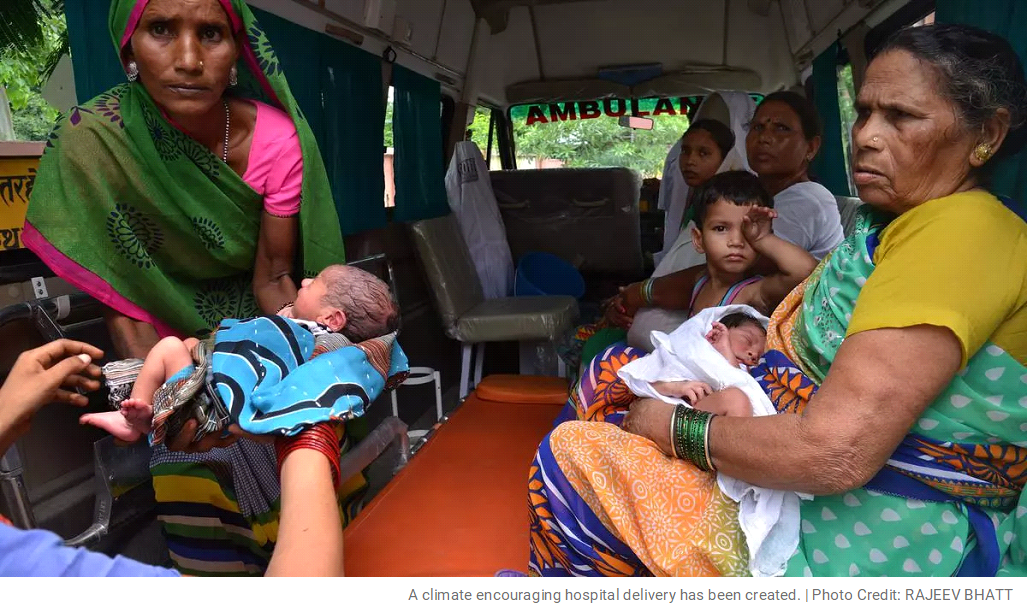The piquant case of a successful maternity benefit scheme
01 Mar 2024
Opinion: Debasis Barik and Sonalde Desai.
Janani Suraksha Yojana, launched in 2005, has helped reduce maternal and neonatal mortality by promoting institutional delivery. But the utilisation of antenatal care has been low.
Creating government programmes to incentivise desired behaviour has a long history in development planning. Unfortunately we have no guidance on when success can be celebrated and the programmes be restructured or allowed to sunset. Janani Suraksha Yojana provides an interesting illustration.
It was instituted in 2005 to encourage hospital delivery through financial incentives. Two types of incentives were provided — payment to new mothers to help defray hospital delivery costs and payment to local health workers to guide women in negotiating access to hospital admission.
This programme has shown remarkable success, with more than 88 per cent deliveries taking place in a hospital. Is it still necessary to continue this programme to avoid backsliding?
JSY is a Centrally sponsored safe motherhood intervention programme that was introduced in 2005 to reduce maternal and neonatal mortality by promoting institutional delivery among poor pregnant women, especially those from Scheduled Castes, Scheduled Tribes, and BPL households. It has been implemented in all States and Union Territories, with a special focus on low-performing States (mainly in north India and north-east).
An expecting mother gets ₹1,400 in rural areas and ₹1,000 in urban areas after delivering at a public health facility or in an Accredited Private Hospital. While SC/ST women get the cash incentive in both low and high-performing States, only women from BPL households get the benefit in high-performing States.
Delivery in hospitals
Institutional delivery has increased from 39 per cent during 2005-06 to 89 per cent in 2019-21. Interestingly, this increase has occurred for both high- and low-performing States and even for women having a third or later children in high-performing States who are not eligible for the benefit.
This suggests that a climate encouraging hospital delivery has been created. At the same time, the cost for hospital delivery has risen sharply, reducing the importance of JSY incentives in overall expenditure.
The National Family Health Survey (2019-21) reported that the average out-of-pocket cost of hospitalisation delivery was ₹10,035 (₹24,663 in private and ₹3,245 in public facilities), far more than the ₹1,400 and ₹1,000 incentive.
This begs the question, is it time to allow the programme to sunset? Or at least be restructured to focus on elements of maternal care that have not shown improvement? Though there was a tremendous rise in hospital delivery, limited progress was noted in the uptake of ANC (antenatal) care. Pregnant women who went for at least three ANC visits got two TT injections, and consumed iron folic acid tablets/syrup for at least 100 days increased from 9.3 per cent to 25.7 per cent between 2005-06 and 2019-21. Moreover, there remains a huge gap in the utilisation of ANC care across different population groups. Low utilisation of ANC care is still a major concern among the poor, and SC/ST women and for higher-order births.
Therefore, it would be worth focusing on the pre- and post-delivery components of maternal health now to achieve the broad goal of improvement in maternal and child death.
Alternatively, some refinement of the programme can be undertaken to address disparities within a State. Even in some of the so-called “low-performing States” some districts have hospital delivery rates of over 96 per cent (example, Hamirpur or Mahoba in UP) while some of the districts in high-performing States continue to have low utilisation — example, Mewat in Haryana has 74.6 per cent hospital delivery rate. Within States, resource transfer to encourage hospital delivery in low-performing districts may improve programme coverage without much political cost.
Just as we evaluate and restructure programmes that perform poorly, it is important to periodically evaluate successful programmes to ensure that the funds and health worker efforts are utilised to provide the greatest benefit for the programme expenditure.
Barik is Fellow, NCAER and Desai is Professor, NCAER
Published in: The Hindu Business Line, 01 Mar 2024






